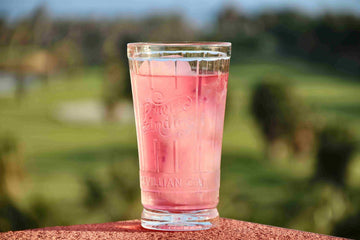Sloe Gin Vs Gin - What’s the Difference? | Filey Distillery
by William Rusling on Feb 29, 2024
Welcome to the intriguing world of gins! If you’ve ever found yourself pondering the distinction between Sloe Gin and traditional Gin, you’re in the right place. Whether you're a cocktail connoisseur or a curious beginner, this guide will illuminate the subtle and not-so-subtle differences between these two spirited cousins. So grab a glass, and let’s embark on a flavorful journey to discover what sets these two apart.
What Is Sloe Gin?
Sloe Gin is made by infusing gin with sloe berries, the small, tart fruit of the blackthorn bush, and adding a touch of sweetness. This process gives Sloe Gin its characteristic deep ruby colour and a rich, fruity flavour that's both sweet and slightly astringent.
Unlike its clear counterpart, Sloe Gin is lower in alcohol content, typically around 20-30%, making it a perfect ingredient for a variety of cocktails or a delightful sipper on its own.
Differences between Gin and Sloe Gin
The main difference between Gin and Sloe Gin lies in their flavour profiles and production methods. Traditional Gin is a distilled spirit known for its clear appearance and juniper-dominated flavour, often complemented by various botanicals.
Sloe Gin, on the other hand, is a liqueur created by infusing gin with sloe berries and sugar, resulting in a sweeter, fruitier, and lower-alcohol beverage with a deep ruby colour. While Gin is celebrated for its crisp, botanical taste, Sloe Gin offers a richer, berry-infused flavour experience.
Ingredients and Production Process
Traditional Gin
Traditional Gin is crafted primarily from juniper berries, combined with a range of botanicals like coriander, citrus peels, and various herbs and spices. This mixture is then distilled, often multiple times, to create a clear, aromatic spirit that's rich in flavour.
Sloe Gin
Sloe Gin, on the other hand, starts its life as regular gin. It is then infused with sloe berries, the fruit of the blackthorn bush, and sugar. This infusion process, which can take several months, allows the gin to absorb the deep, rich flavours and the ruby red colour of the sole berries. The result is a liqueur that's distinctly different from its base spirit in both taste and appearance.
Flavour Profile and Characteristics
Traditional Gin
Gin is celebrated for its crisp, clean taste with a pronounced juniper flavour. This juniper-forward profile is often complemented by notes of citrus, pine, and floral hints, varying based on the botanicals used in distillation. If you’re interested in trying an award winning traditional gin, consider Fliey Distillerys signature gin.
Sloe Gin
Sloe Gin, in contrast, offers a much sweeter and fruitier taste. The sole berries impart a natural sweetness and a slightly tart, berry-like flavour, which balances the botanical notes of the base gin. This results in a liqueur that is smoother and generally less complex in terms of botanical flavours, but rich in fruity notes.
Alcohol Content and Serving Suggestions
Traditional Gin typically has an alcohol by volume (ABV) of around 40-50%, classifying it as a strong spirit.
Sloe Gin, being a liqueur, has a lower ABV, usually in the range of 20-30%.
In terms of serving, Gin's versatility shines in cocktails. Classics like the Martini and Gin and Tonic showcase its botanical complexity.
Sloe Gin, with its sweeter profile, is often enjoyed neat or on the rocks. It also adds a delightful twist to cocktails, particularly those that benefit from its fruity sweetness, such as a Sloe Gin Fizz or a Sloe Gin Negroni.
How Is Sloe Gin Made?
Sloe Gin is a unique liqueur that combines the complexity of gin with the rich, fruity flavour of sloe berries. Its production process differs significantly from that of traditional gin, resulting in a distinct beverage. Let's explore this process in easily digestible steps.
Harvesting Sloe Berries
The journey of Sloe Gin begins with the harvest of sloe berries. These berries, from the blackthorn bush, are typically gathered after the first frost of autumn. This timing is crucial as the frost helps to soften and naturally sweeten the berries.
Preparing the Berries
Once harvested, the berries are pricked, often using a thorn from the blackthorn bush itself. This small but important step aids in releasing the juices and flavours from the berries during the infusion process.
Infusing with Gin
The prepared berries are then placed in a container and covered with gin. The choice of gin can vary, but a standard, clear gin is usually preferred. This ensures that the delicate flavour of the sloe berries is not overpowered by the botanicals in the gin.
Adding Sugar
Sugar is added to the mixture of sloe berries and gin. The sugar serves dual purposes: sweetening the liqueur and helping to extract the flavours from the sole berries more efficiently.
The Infusion Process
After combining all ingredients, the container is sealed and left to infuse. This period can range from several months to a year, with occasional agitation to ensure a uniform flavour profile. During this time, the gin slowly absorbs the essence and colour of the sole berries.
Final Steps: Filtering and Maturation
Upon reaching the desired maturity, the Sloe Gin is filtered to remove the berries and any sediment. This leaves behind a smooth, richly flavoured liqueur, which contrasts significantly with the clear, crisp nature of traditional gin.
Contrast with Traditional Gin Production
In contrast to this lengthy infusion process, traditional gin is typically made by distilling grain alcohol with juniper berries and other botanicals, a method that doesn't involve the long maturation period seen in Sloe Gin production. You can learn more about the gin distillation process, on one of our distillery tours.
What Does Sloe Gin Taste Like?
Sloe Gin offers a unique taste profile that is markedly sweeter and fruitier than traditional gin. It has a rich, smooth flavour with notes of ripe berries, a slight tartness from the sole berries, and a subtle hint of almond. This combination creates a balance between sweetness and a gentle, lingering tartness, making Sloe Gin a delightful and distinctive liqueur.
What Is a Sloe Gin Fizz?
A Sloe Gin Fizz is a classic cocktail that combines the fruity sweetness of Sloe Gin with the brightness of lemon juice, the soft sweetness of simple syrup, and the effervescence of soda water. This drink is light, refreshing, and slightly fizzy, making it an ideal choice for those who enjoy a cocktail with a balance of sweet and tart flavours, uplifted by a bubbly texture.
Conclusion
Sloe Gin, with its rich, fruity flavours and deep, ruby hue, stands out in the world of spirits as a delightful and versatile liqueur. Whether you're savouring it neat, mixing it into a classic Sloe Gin Fizz, or exploring other creative cocktails, this unique gin variant is sure to offer a charming and indulgent experience
FAQs
How is Sloe Gin Different from Gin?
Traditional gin is distilled with juniper berries and other botanicals, Sloe Gin is a liqueur made by infusing gin with sloe berries and sugar. This results in a sweeter, fruitier flavour profile and a lower alcohol content for Sloe Gin compared to the more botanical and higher-alcohol traditional gin.
What Does Sloe Gin Taste Like?
Sloe Gin has a distinctly sweet and fruity taste, with rich berry flavours and a slight tartness from the sloe berries. There's also a subtle hint of almond and a mellow, smooth finish, differentiating it significantly from the crisp, juniper-forward taste of traditional gin.
Can You Drink Sloe Gin by Itself?
Yes, Sloe Gin can be enjoyed by itself. Its sweeter, milder flavour and lower alcohol content compared to traditional gin make it a pleasant sipping liqueur. It is often served neat, chilled, or over ice, allowing the rich, fruity flavours to be fully appreciated.
How is Sloe Gin Drunk?
Sloe Gin can be drunk in several ways. It's versatile enough to be enjoyed neat, on the rocks, or as part of a cocktail. Popular cocktail choices include the Sloe Gin Fizz and the Sloe Gin Negroni. Its sweet and fruity profile also makes it a great addition to champagne or sparkling wine for a festive drink.



